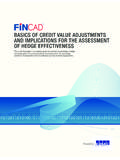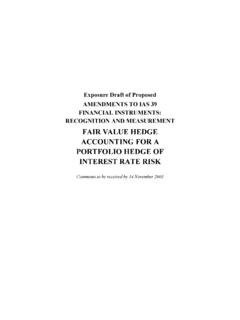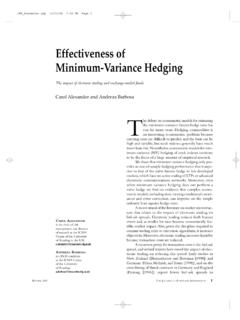Transcription of Hedge Accounting - Forward Contracts - baroda …
1 Hedge Accounting ( ). Forward Contracts Agenda Introduction to Hedging Definitions Types of hedging relationships z Fair value Hedge z Cash flow Hedge z Net investment Hedge AS-11 V/s. AS-30 framework Hedging Policy & Hedge Accounting RANBAXY moving towards maturity ? Q&A. 2. Agenda Introduction to Hedging Definitions Types of hedging relationships z Fair value Hedge z Cash flow Hedge z Net investment Hedge AS-11 V/s. AS-30 framework Hedging Policy & Hedge Accounting RANBAXY moving towards maturity ? Q&A. 3. Types of exposures Transaction exposure Most common in today's business environment, this relates to foreign exchange rates fluctuation Translation exposure Arises from the need to translate foreign currency assets / liabilities into the home currency Economic exposure Change in the exchange rates of another currency may worsen / boost competitiveness.
2 4. Why Hedge ? Knocking the doors of global market can be an effective way of expanding business. However, success of enterprise is equally tied with volatility in foreign exchange rates thanks to constant rate fluctuations contributing to unexpected profit or loss. Forex hedging is meant to diminish the risk associated with an enterprise's exposure to foreign currency balances and transactions. It is in the best interest of any organisation to recognise this risk and formulate appropriate hedging strategy to safeguard against currency fluctuations with an ultimate aim to create assurance for cost and revenue.
3 5. What is hedging ? Hedging means entering into a financial contract ( FX option or Forward contract ) with a bank in order to offset the (gain or) loss arising from FX movements (in Assets, Liabilities, firm commit. or forecast transaction). A method, often sophisticated, employed to minimize investment risk. Holders of a given underlying (currency) might reduce risk on a relatively basic level level, for instance instance, by entering/buying Forward Contracts /options; in case of an adverse currency development, the Forward Contracts / options allows the holders to buy or sell the underlying at a pre-determined (fixed) level, providing a Hedge .
4 Against i t llosses. 6. FX Environment EUR/CHF chart 7. FX Environment EUR/USD chart 8. What is hedging ? Hedging is like a tree guard around the tree which protects tree from cattle / Animal Hedging H d i program FC assets /. liabilities Hedging instruments FC Market fluctuations 9. Agenda Introduction to Hedging Definitions Types of hedging relationships z Fair value Hedge z Cash flow Hedge z Net investment Hedge AS-11 V/s. AS-30 framework Hedging Policy & Hedge Accounting RANBAXY moving towards maturity ? Q&A. 10. Hedged item and Hedging instrument Hedged item : A hedged item is an asset, liability, firm commitment, highly probable transaction, or investment in a foreign operation that exposes p an entity y to changes g in fair value or cash flows,, and is designated as being hedged.
5 Hedging instrument : A hedging instrument is a designated financial instrument whose fair value or related cash flows should offset changes in the fair value or cash flows of a designated hedged item. 11. Firm commitment and forecast transaction Firm commitment : A binding agreement for the exchange of a specified quantity of resources at a specific price on a specified future date(s). Forecast transaction : A transaction that is expected to occur (highly probable) for which there is not a firm commitment Does not give an entity any present right to future benefits or a present obligation for future sacrifices 12.
6 Derivatives Derivatives are weapons of mass destruction . - Warren Buffet Derivatives Derivatives are financial instruments whose value changes in response to the changes in underlying variables, requires no initial investment or initial investment that is smaller than would be required for other types of contract that would be expected to have similar response p to change g in market factors and it is settled at future date. 13. Freestanding derivatives - definitions Three characteristics Fair value changes in response to the change in underlying z Interest rate No initial z Financial net investment instrument price or an initial z Commodity price net investment that is smaller z Foreign exchange than would be rate Settled required for at a future date z Credit rating/index other types of z Index I d of f prices i or Contracts that rates would be expected to have z Other variables (in a similar the case of a non- response to financial variable changes in - it is not market)
7 Factors specific to a party 14. to the contract ). No derivative without underlying Derivative Smoke U d l i Underlying 15. Types of derivatives Future Forward Swap Option contract to buy or sell a non-financial item that can be settled net in cash or another financial instrument or by exchanging financial instruments (specifically included in AS 30, although not a financial instrument). 16. Types of derivatives. Forward contract Forward contract a contract to buy or sell an amount of a currency at a defined rate (expressed in another currency) at a future defined date, the defined rate is the Forward Rate at Inception 17.
8 AS 30 excludes following derivatives All derivatives are always marked-to-market (MTM) with changes in fair value recognised in the P&L (unless used as hedging instruments in cash flow Hedge when fair value changes are in reserves) except for: Contracts for normal' Regular way purchase or sale purchases and sales of non- of a financial asset financial items z Delivery D li within ithi a ti time fframe z Intended to meet purchase, established by regulation or sale or usage requirements convention in the market z Designated for that purpose z Apply trade date or settlement date Accounting z Will be settled by delivery 18.
9 Components of Hedge relationship H d i Hedging relationship l ti hi components t Hedged items Hedgeable risks Hedging instruments 19. How perfect Hedge actually works ? Every change in the fair market value of forex Hedge instrument will have an opposite impact on forex hedged item in a way to achieve certainty in cost and revenue. Derivatives. Changes in the fair market value of forex Hedge instrument Changes in the fair market value of hedged item Reco. A. R Assets/Liabilities, t /Li biliti Fi Firm Commit, Highly prob. Fore. txn. 20. Criteria for Hedge Accounting 1.
10 Hedge relationship must be documented at inception z Risk management objective and strategy for the Hedge z Identification of the hedging instrument z The related hedged item or transaction z The nature of the risk being hedged z How hedging instrument's effectiveness will be assessed 2(a) Hedge relationship must be expected to be highly effective at inception and subsequent b t periods i d 2(b) Hedge effectiveness can be reliably measured 2(c) Actual Hedge effectiveness must be measured 3. In the case of hedging future cash flows, there must be a high probability off th thatt cash h flow fl occurring i 21.





